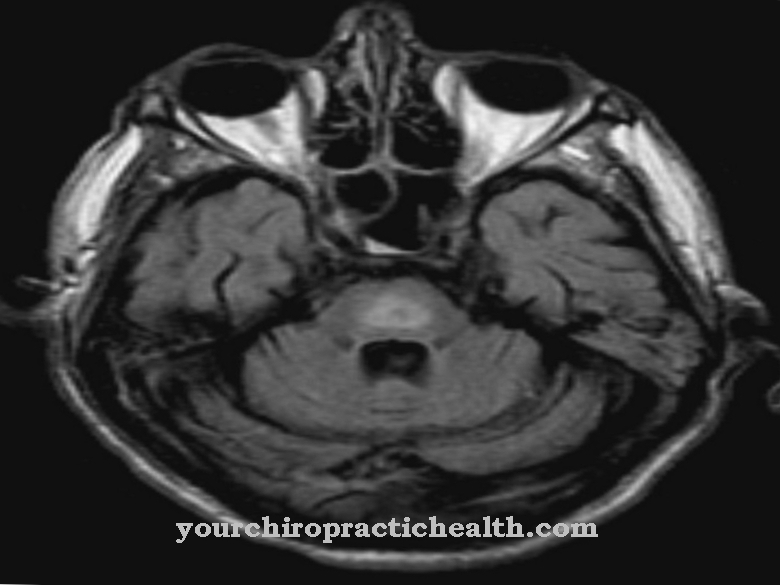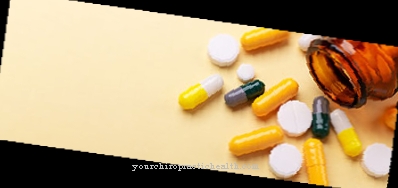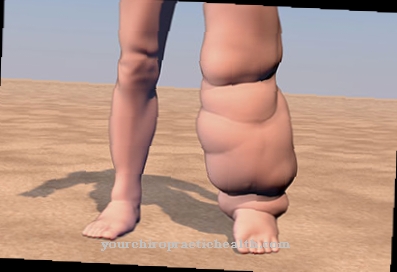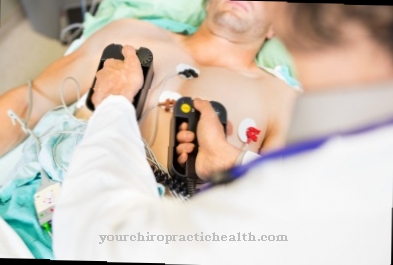The Hand, foot and mouth disease is a viral and highly contagious infectious disease that often reaches epidemic proportions, particularly in the Pacific and Southeast Asia. The disease mainly affects children and manifests itself mainly in fever and painful skin rashes as well as blisters in the mouth, on the palms of the hands and the soles of the feet, although in rare cases a brainstem inflammation can be associated with the disease.
What are the characteristics of hand, foot and mouth disease?

© groisboeck - stock.adobe.com
The physician understands hand, foot and mouth disease to be a highly contagious but mostly harmless viral disease. The viral infectious disease occurs worldwide and may spread epidemically due to the high risk of infection. Children under ten years of age are particularly likely to get the virus, but adults are not immune from the infection either.
The incidence of illnesses generally reaches a maximum value in late summer, but the occurrence is ultimately not limited to a certain season. The disease was first documented in 1948 by Dalldorf and Sickles. Although the incidence of this disease is not limited to a specific habitat, it affects Southeast Asia and the Pacific in particular.
The infection there is usually epidemic and significantly more serious than in Europe. It is estimated that six million people will contract the virus disease within a decade, with the infection being fatal for around 2000 of them. In relation to the western world, however, a fatal course is rather rare.
causes
In most cases, hand, foot and mouth disease can be traced back to group A enteroviruses, which include, in particular, Coxsackie A viruses and the human enterovirus 71. By far the most common pathogens are Coxsackie A16 viruses. The epidemic infectious disease is transmitted from person to person via body fluids such as droplets, saliva or vesicular secretion, but faecal-oral transmission is also possible.
The pathogens of the virus enter the regional lymphatic system via the intestines or the oral mucosa, from where they reach the bloodstream within a few days. No direct contact with an infected person is necessary for transmission. This means that transmission is also possible if a person concerned has contaminated a chair, table or object with saliva or other body fluids and a healthy person comes into contact with this contaminated object.
Symptoms, ailments & signs
Hand, foot and mouth disease manifests itself in the first few days through fever and general symptoms. A few days later, painful enanthemums and blisters appear on the oral mucosa on the tongue, the palate, or the gums and the mucous membrane of the cheeks. In the following days, the vesicles become coated and painful aphthae, with a symmetrical rash often developing at the same time.
Often the inner surfaces of the hands, the buttocks and the soles of the feet are also affected by blisters, which are accompanied by severe itching. In rare cases, a loss of fingernails and toenails continues.
If human enterovirus 71 is the cause of the disease, aseptic meningitis or brainstem encephalitis can occur. Cerebral stem inflammation usually manifests itself as a flaccid paralysis, which is due to a lesion of the lower motor neurons in the spinal cord. Usually these motor neurons are completely destroyed, which often makes the symptoms of paralysis irreversible.
Diagnosis & course
The doctor first makes the diagnosis of hand, foot and mouth disease using visual diagnostics. before he detects the pathogen with a stool sample. Laboratory diagnostics are usually not initiated because the diagnosis is relatively certain and, especially in the western world, a mild course is expected anyway. In a differential diagnosis, the doctor must rule out chickenpox and foot-and-mouth disease, which he covers by mere detection of the pathogen.
In almost all cases in this country the disease heals completely within one to two weeks without causing complications. Also, if the infection is associated with aseptic meningitis, a complete cure can be expected. If, on the other hand, brainstem encephalitis occurs, this can be classified as a dangerous complication, which often leads to neurogenic pulmonary edema with high lethality. With this severe form of infection, severe neurological deficits remain in most cases.
Complications
The hand-foot-mouth disease is very dangerous for humans and in the worst case can lead to the death of the patient. For this reason, this disease must always be treated promptly by a doctor. The affected person suffers from a high fever and blisters in the mouth. Rashes also appear on the skin, which in most cases are associated with severe pain.
Furthermore, the disease can spread to the brain and lead to inflammation there, which leads to limitations in the patient's cognitive abilities. The quality of life is significantly reduced by the hand, foot and mouth disease. The person concerned is only slightly resilient and can no longer easily carry out everyday activities. The inflammation in the brain often leads to paralysis and epileptic seizures.
Likewise, thought processes can no longer be carried out correctly and the person concerned suffers from confusion and from coordination disorders. No causal treatment for hand, foot and mouth disease is possible. Because of this, only the discomfort and pain of this disease can be relieved. There are no further complications. Without treatment, life expectancy is drastically reduced.
When should you go to the doctor?
Hand, foot and mouth disease is highly contagious, so a doctor should be consulted at the first sign, simply because of the risk of infection for the environment. Most of those affected also have to see a doctor about the symptoms of the disease so that the symptoms of the disease are relieved. Many suffer from pain in their arms, feet and mouth, as well as pain in their limbs, fatigue and fever.
The disease itself does not necessarily have to be treated with medication because it usually heals on its own without complications, but it is often necessary to alleviate the accompanying symptoms. The itching on the skin can be dampened with medication, with paracetamol or similar the fever can be lowered. Tinctures and mouthwashes can help against the painful inflammation in the mouth, e.g. B. rinses with chamomile, thyme or lemon balm. Sometimes an inflammation can spread very much in the mouth and must then be treated with antibiotics.
Doctors & therapists in your area
Treatment & Therapy
The treatment of hand, foot and mouth disease is symptomatic. A causal treatment is not possible because the pathogens do not react to the known drugs used to contain viral infections. To relieve the pain, pain reliever gels are applied to the areas of all skin lesions.
In this way, a secondary infection is to be prevented, which is particularly favored by strong scratching. Because some patients take in little food and fluid due to the painful changes in the oral mucosa, the supply can either be facilitated through a straw or ensured through injections.
Outlook & forecast
The overall prognosis for hand, foot and mouth disease is favorable. Although the disease is highly contagious, spreads quickly and primarily affects patients whose immune systems are not fully functional, the infection usually heals completely within a few days.
Hand, foot and mouth disease is characteristic of healing within seven to ten days. During this time, all complaints that had occurred have regressed. Some skin changes that have occurred may take a few days longer before no traces can be seen. Under normal conditions, the patient is considered symptom-free and completely recovered after this time.
Complications or sequelae are only to be expected in isolated cases and in exceptional situations. People with a severely weakened immune system may develop other diseases that may make their health worse or take longer to heal. Mostly newborns, infants or the elderly are affected by the complications.
The body's own defenses are either not yet sufficiently developed or already weakened due to other diseases or the natural breakdown process. The risk groups can suffer from meningitis. In addition, the hand, foot and mouth disease threatens to spread to the internal organs.
In severe cases, functional disorders or irreparable damage to the organic tissue can occur. This development of the disease is considered extremely rare when the patient is seeking medical care.
prevention
In order to prevent hand, foot and mouth disease, hygiene measures must be observed above all, such as washing hands with soap. As a preventive measure, a healthy person should not have any close contact with the sick. So far there is no vaccine against the disease. Although three monovalent vaccines against the human enterovirus 71 were developed in China, they were all associated with complications for those vaccinated.
Aftercare
In most cases of hand, foot and mouth disease, the patient has only a few direct follow-up measures available. The person concerned is primarily dependent on a quick diagnosis so that the disease can be treated properly and further complications can be avoided. The hand, foot and mouth disease cannot heal itself, so that the person concerned is usually always dependent on medical treatment.
In order to prevent further infection of the hand, foot and mouth disease, strict hygiene measures should be observed. The patient should also avoid unnecessary contact with other people as far as possible so that the disease cannot spread. Bed linen and ordinary clothing should also be washed at a high temperature to further reduce the risk of infection.
Since the disease is usually treated with the help of medication, the patient should ensure that it is taken regularly with the correct dosage. If you have any questions, ambiguities or side effects, you should always consult a doctor first. The disease can be limited relatively well so that there are no further complications if it is recognized early. As a rule, the life expectancy of the person affected is not reduced.
You can do that yourself
If the hand, foot and mouth disease has broken out, the main thing to do is to apply hygiene. In order to put a stop to the viral disease and to protect family members and friends, it is necessary to interrupt the cycle of infection.
Frequent and thorough hand washing with soap is the first step. Possible contamination surfaces must be disinfected after use. These include the toilet, the washbasin with all fittings or the changing table.
Cups and materials used at the same time should not be shared with others. You should also be careful when hugging, kissing and shaking hands. The affected child should be helped not to cough or sneeze into the surrounding area. Hands should generally be kept away from the eyes to prevent possible conjunctivitis.
Cooling measures such as cold compresses counteract the itching. Cool packs or putting on cold tea bags prove to be helpful. The bags of black tea, chamomile, thyme and lemon balm tea can be used for this.
The cold tea relieves the discomfort in the mouth, throat and throat area and prevents the body from drying out. If you have difficulty swallowing or refuse to eat, the use of water ice is worthwhile. During the course of the illness, stays in larger groups of people should be avoided.








.jpg)



















